
Samarkand, also known as Samarqand, is a city in southeastern Uzbekistan and among the oldest continuously inhabited cities in Central Asia. There is evidence of human activity in the area of the city from the late Paleolithic Era. Though there is no direct evidence of when Samarkand was founded, several theories propose that it was founded between the 8th and 7th centuries BCE. Prospering from its location on the Silk Road between China, Persia and Europe, at times Samarkand was one of the largest cities of Central Asia. Most of the inhabitants of this city are native speakers of Tajik dialect of Persian language. This city is one of the historical centers of the Tajik people in Central Asia, which in the past was one of the important cities of the great empires of Greater Iran.
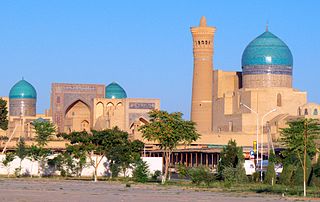
Bukhara is the seventh-largest city in Uzbekistan, with a population of 280,187 as of 1 January 2020, and the capital of Bukhara Region.

Navoiy, also spelled Navoi, is a city and the capital of Navoiy Region in the southwestern part of Uzbekistan. Administratively, it is a district-level city, that includes the urban-type settlement Tinchlik. It is located at latitude 40° 5' 4N; longitude 65° 22' 45E, at an altitude of 382 meters. The city is named after Ali-Shir Nava'i. As of 2020, its population was 144,158 inhabitants.
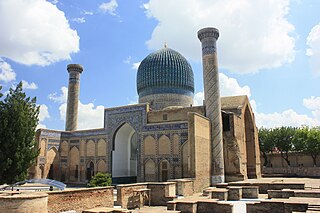
The Gūr-i Amīr or Guri Amir is a mausoleum of the Turco-Mongol conqueror Timur in Samarkand, Uzbekistan. It occupies an important place in the history of Central Asian Architecture as the precursor for and had influence on later Great Mughal architecture tombs, including Gardens of Babur in Kabul, Humayun's Tomb in Delhi and the Taj Mahal in Agra, built by Timur's Indian descendants, Turco-Mongols that followed Indian culture with Central Asian influences, Mughals established the ruling Mughal dynasty of the Indian subcontinent. The mausoleum has been heavily restored.

Bayan Qulï was khan of the Chagatai Khanate from 1348 to 1358 and a grandson of Duwa.
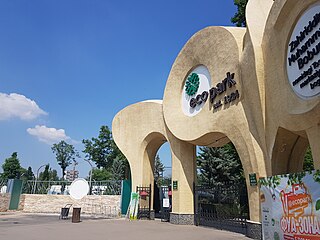
Today, the museums of Uzbekistan store over two million artifacts, evidence of the unique historical, cultural, and spiritual life of the Central Asian peoples that have lived in the region.

The Samanid Mausoleum is a mausoleum located in the northwestern part of Bukhara, Uzbekistan, just outside its historic center. It was built in the 10th century CE as the resting place of the powerful and influential Islamic Samanid dynasty that ruled the Samanid Empire from approximately 900 to 1000. It contained three burials, one of whom is known to have been that of Nasr II.
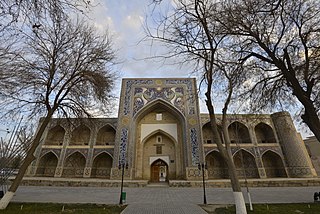
Lab-i Hauz, sometimes also known as Lyab-i Khauz, a Russian approximation, is the name of the area surrounding one of the few remaining hauz pools that have survived in the city of Bukhara, Uzbekistan. Until the Soviet period, there were many such pools, which were the city's principal source of water, but they were notorious for spreading disease and were mostly filled in during the 1920s and 1930s.

Sheihantaur, the mausoleum of Sheikh Hovendi at-Tahur, is an architectural monument in Tashkent, Uzbekistan.

Po-i-Kalan, or Poi Kalan, is an Islamic religious complex located in Bukhara, Uzbekistan. The complex consists of three parts, the Kalan Mosque, the Kalan Minaret to which the name refers to, and the Mir-i-Arab Madrasah. The positioning of the three structures creates a square courtyard in its center, with the Mir-i-Arab and the Kalan Mosque standing on opposite ends. In addition, the square is enclosed by a bazaar and a set of baths connected to the Minaret on the northern and southern ends respectively.

A mazār, also transliterated as mazaar, also known as darīh (ضَرِيْح) in the Maghreb, is a mausoleum or shrine in some places of the world, typically that of a saint or notable religious leader. Medieval Arabic texts may also use the words mašhad or maqām to denote the same concept.
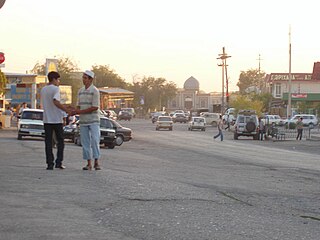
Sayram is a rural locality located in southeastern Turkistan Region on the Sayram Su River, which rises at the nearby 4000-meter mountain Sayram Su. In medieval times, the city and countryside were located on the banks of the Arys River, into which the Sayram Su river flows. It is now a suburb of Shymkent. Population: 30,887 ; 25,408.
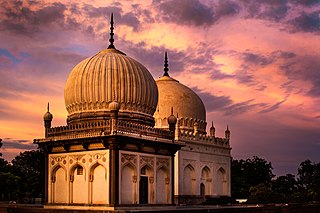
The Qutub Shahi Tombs are located in the Ibrahim Bagh, close to the famous Golconda Fort in Hyderabad, India. They contain the tombs and mosques built by the various kings of the Qutub Shahi dynasty. The galleries of the smaller tombs are of a single storey while the larger ones are two storied. In the centre of each tomb is a sarcophagus which overlies the actual burial vault in a crypt below. The domes were originally overlaid with blue and green tiles, of which only a few pieces now remain.
The Arab-Ata Mausoleum is a cubical, domed brick mausoleum built in 977-78 in the village of Tim, Samarqand Region, Uzbekistan. Built during the Samanid Empire, the Arab-Ata Mausoleum was among the earliest buildings to include three notable features of Islamic architecture: the muqarnas, mihrab, and pishtaq. Following the appearance of the mihrab in the Arab-Ata mausoleum, mihrabs became a more common feature in mausoleums from the tenth century on. The Arab-Ata is the earliest dated example of a pishtaq, with it becoming a staple of Islamic architecture. It has been proposed that the pishtaq developed further with the many Seljuq domes from the 11th and 12th centuries.

A qubba, also transliterated as ḳubba, kubbet and koubba, is a cupola or domed structure, typically a tomb or shrine in Islamic architecture. In many regions, such as North Africa, the term qubba commonly the tomb of a local wali or marabout, and usually consists of a chamber covered by a dome or pyramidal cupola.

Abū al-Maʿālī Sayf al-Dīn Saʿīd b. al-Muṭahhar b. Saʿīd Bākharzī (al-Bākharzī, Persian: باخرزی shortened as Sayf al-Dīn Bākharzī, was a poet, sheikh, and theologian who lived in the 13th century. As suggested by his nisba, he was born and raised in Bakharz, a district of the province of Quhistan in Khorasan, and he got religious education in Herat and Nishapur cities. When he achieved unusual successes in mystical teaching, he moved to Khorezm. There he became one of nearest followers of very popular sheikh – Nadjm ed-Din Kubra. Afterwards, according to the prominent poet Abdurahman Djami Boharsi, Sheikh Saif ed-Din went to Bukhara as a tutor. In Bukhara he was honored with the title of "Sheikh al-Alam".
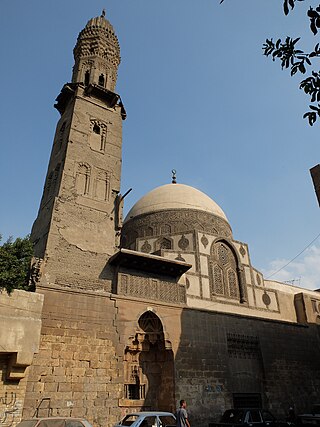
The Madrasa of Amir Sunqur Sa'di, also commonly known as the Mausoleum of (Sheikh) Hasan Sadaqa, is a medieval Mamluk-era madrasa structure and mausoleum in Cairo, Egypt. It was originally built between 1315 and 1321 CE by amir Sunqur Sa'di. Sunqur was forced to leave Egypt in his lifetime and was never buried there, but a sheikh known as Hasan Sadaqa was later buried in it and therefore the building is often known by his name. From the 17th century onward the complex was converted into Mevlevi Sufi lodge and is open today as the Mawlawiyya Museum or Museo Mevlevi.
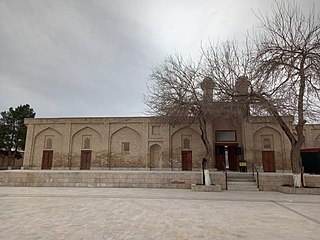
'Abd al-Ahad Khan's mausouleum is an architectural monument that is part of the Qasim Sheikh complex in Karmana. It was built in 1911 by the emir of Bukhara Sayyid Mir Muhammad Alim Khan around the grave of his father 'Abd al-Ahad Khan. It is located in the southwestern part of Muhammad ibn al-Qasim Sheikh complex. Archaeologists have studied and said that there are no corpses (bones). It was restored in 2000-2001, and again restored in 2017, during the restoration in 2017, the rooms on the north side of the mausoleum were completely demolished and then again restored.



















